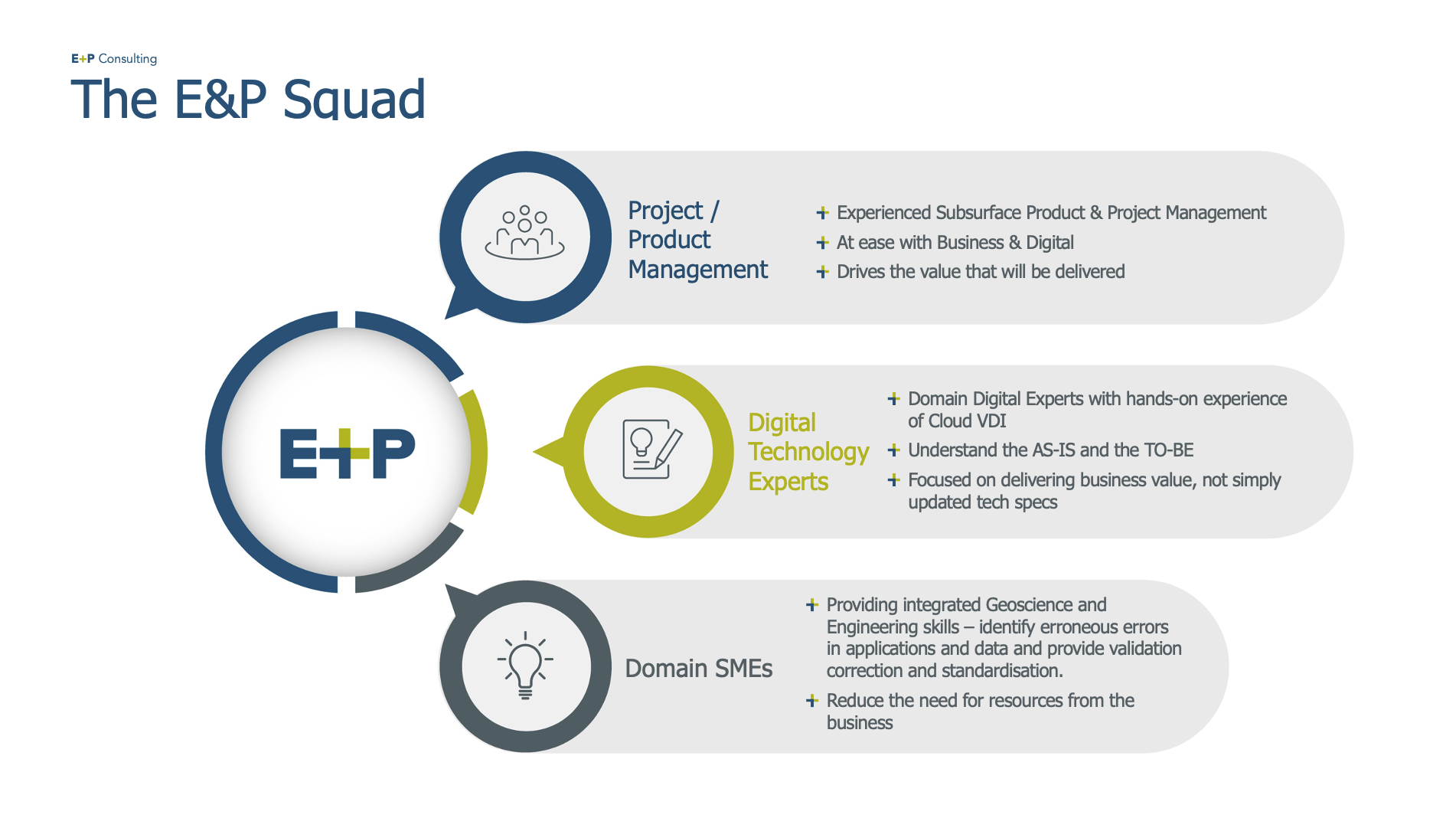Migrating to Cloud-based VDI in Subsurface
3 July 2024 — E&P - Ian Stewart

Cloud Virtual Desktop Infrastructure (VDI) has been around for some time, but with the capability to support the complex and evolving needs of the energy sector, it has become an important part of energy sector business operations. Energy companies are leveraging cloud VDI to enhance remote work capabilities, achieve cost efficiencies, streamline operations, overcome data storage capacity limitations, mitigate data security compliance issues, and support global digital transformation initiatives.
So, when it comes to Subsurface, how do you ensure a seamless migration to a cloud VDI solution, and what are the key considerations to fully unlocking the value of your new virtual platform?
Why Have Cloud-Based Solutions Become So Important for Subsurface?
Cloud solutions have rapidly evolved to support the unique demands and challenges of the energy sector. By comparison, physical or virtual on-premise solutions can no longer support how the energy sector operates today.
On-premise physical infrastructure requires high capital expenditures and significant maintenance and refresh costs. The inherent nature of these solutions also means these costs spike every 3–5 years as large-scale hardware refresh projects are conducted. Numerous resources are also required to operate these physical platforms. In addition, as cloud-based solutions have become more prevalent, the skills needed to support legacy platforms have become scarce.
Modern workforces have also evolved. The sector saw remote working demands increase following the COVID-19 pandemic era, but it also became apparent that on-site working was not always necessary. Hybrid working was quickly established, and people started to expect to be able to work flexibly, use mailable toolkits, and quickly adapt to changing requirements—legacy, physical, on-premise solutions struggle to offer this kind of capability.
Many new hardware and software advancements are also now only offered via cloud-based platforms. Therefore, staying with legacy on-premise solutions will ultimately cause eventual losses in functionality, compatibility, and competition.
The Subsurface Computing Challenge
The software required to support the exploration, development, and operation of oil and gas assets is complex and requires specialist storage and graphical processing capability. Data volumes routinely reach Petabytes in size, memory requirements are 100 gigabytes +, and graphics processing units (GPU) are at the very top end. Traditionally, this has been delivered ‘on-premise’ via high-end workstations (under desks or in regional data centres) supported by local storage platforms.
Technology has evolved to make this capability available in the cloud via high-performance VDI and scalable storage. Leaping to these new cloud-based platforms is significant and requires specialist support to ensure the actual value of these new platforms is unlocked.
E&P Consulting works directly with Subsurface teams to understand their digital and data ambitions and bring the right domain expertise to help deliver those ambitions. Our domain experts speak the language of the energy business, enabling them to hit the ground running and deliver at pace.
We typically come up against the following six barriers to success:
- Technology solutions differ from on-premise solutions and can have a significant impact on transition length, performance, and cost.
- Transitions are not seamless and require significant collaboration with business stakeholders.
- If left uncontrolled, the costs of these solutions can run out of hand due to the elastic nature of the solution.
- Skills and knowledge in these environments are limited; they are only now moving out of the early adopter’s stage.
- The effort required to transition to these platforms is great and cannot be absorbed by existing teams.
- Regional restrictions, technically, legally, and politically, can present significant hurdles to overcome (particularly on data ownership).
Through our network of skilled digital domain experts, we have the capability to identify and address all these key barriers to success, ensuring cloud VDI platforms are up and running quickly and deliver what is needed from the get-go.
E&P Consulting’s Approach to Mitigate Cloud VDI Migration Issues
Whether you are moving from a legacy distributed physical platform or an on-premise VDI solution, the challenge is significant, as a wide range of skills and capabilities are required to deliver and manage any solution.
The team at E&P has extensive experience in this area. We have supported our clients in the area for many years, from PoC and MVP to global deployments and support.
We work right across the delivery stack, from design, architecture, change, and deployment to operational support and ongoing management.
We understand which delivery frameworks work (e.g., scrum vs. waterfall vs. hybrid), and we also understand vital technical concepts that underpin these platforms, like resource planning, pool management, and security and compliance.
We also have extensive experience migrating subsurface applications and data through on-premise and cloud solutions. We can assess the various cloud platforms and support strategic decision-making confidently. This includes understanding critical pillars such as storage platforms, connection brokers, and automation for testing and provisioning.
The E&P Squad
We work with our clients to assemble tailored squads to support the migration journey for cloud VDI solutions. This involves building the best squad with the right technical and communication skills to ensure a solid outcome for any cloud VDI project.
This typically incorporates Project / Product Management, Digital Technology Experts, and Domain SMEs, with each squad fulfilling a defined role and deliverable to support the project from end-to-end.

Key Considerations to Ensure Successful Delivery of Cloud VDI Solutions
When embarking on your cloud VDI migration journey, many areas require careful consideration and expert input to ensure the successful delivery of any cloud VDI solution.
E&P has identified five key considerations for Subsurface to drive maximum benefit and value when establishing new cloud VDI platforms.
One: Cloud Platform
Conduct thorough due diligence when selecting a cloud platform. The four significant providers are Microsoft Azure, AWS, Google Cloud, and IBM; however, some companies offer managed VDI solutions tailored for use with subsurface software and data.
Simply going with your already existing platform may not be the correct answer. Several considerations need to be analysed, such as Cloud SKU types and availability in different regional zones, disaster recovery capability, power management features, the ability to dedicate resources and capacity, and alignment with the latest industry standards, such as OSDU.
Two: Data Storage
Obtaining the right balance between cost and performance has long been challenging, but cloud-based technologies can offer a more flexible approach. Several recognised providers with solutions are available, such as Microsoft, Amazon, Google, IBM, and NetApp, along with several ‘new’ cloud service providers, such as Nutanix, Nasuni, and Panzura.
Some key considerations are: pricing model; fast access to data types; geographical reach and access; a balance between hot and cold storage, data archive strategies, and roaming profile solutions such as FXlogix and workspace.

Three: End User Presentation
Multiple cloud connection brokers are available off the shelf, such as Teradici, LeoStream, Citrix, and Exceed TurboX, to facilitate end-user access to VDI platforms. Consider whether you use these or develop a company-specific portal to broker VDIs using existing tools such as RDP.
Close consideration should also be given to whether the solution is externally available—assess the inherent trade-offs between security and convenience. In addition, there are still minimum hardware and software requirements for client devices to ensure service quality. It’s critical to set standards for end-user devices and adhere to them to deliver the best user experience possible.
Four: Application Compatibility
Some application vendors may not fully support VDI implementations of their products for technical or commercial reasons. A detailed analysis is required to look at the potential risks associated with migrating these applications, some of which could be:
- Technical limitations: applications may not be able to utilise cloud-based hardware and software, resulting in underperformance or a complete lack of specific functionality.
- Financial risk: the licensing model may introduce unexpected cost increases if it is not aligned with the elastic nature of cloud platforms.
- Commercial risk: contracts may not cover the use of software in virtual environments and in new regions that can access the software on the new platform.
Five: Ongoing Support
A cloud VDI platform will transform the ongoing support requirements compared to legacy platforms. The transformation comes in the form of new tools and technologies to help manage the platform and the removal of physical ties to regional hardware instances.
- If transitioning from a physical on-premise solution, the skills required are radically different, and the tools available to support and maintain will seem revolutionary. The requirement for physical, hands-on presence is all but gone. No longer tied to geography, support can be delivered from the best source of skills and expertise.
- If transitioning from on-premise VDI, the skills gap will be less; however, several new technologies are still available to streamline support and deployment. These need to be understood and learned from new or existing resources. The release of physical restrictions is also a significant factor, with no need to maintain and manage regional data centres.
While cloud VDI supports a flexible work environment, enabling global teams to work efficiently together, these five considerations highlight the importance of aligning people, processes, and technology. We believe that a solid understanding of the business, deep domain knowledge, and technical experience will maximise the value of any solution delivered. The correct skills, processes, and methodologies assigned to undertake a cloud VDI migration project are crucial to its success.
Why Choose E&P for Your Cloud VDI Migration Project?
With a focus on aligning people, processes, and technology, we combine the skills and capabilities needed to effectively utilise the latest digital technologies and data analytics techniques to achieve your digital goals.
As domain systems and data integrators (SDI), we can help you improve workflows and insights by taking a unified view across data and applications. With this approach, E&P has helped to deliver a range of projects, products, and solutions within traditional upstream areas, from subsurface and drilling and wells to production, capital projects, and work preparation and execution.
Get in touch with us today to find out more about how E&P Consulting successfully combines domain knowledge with experience in the digital sphere and ensure that you fully unlock the potential of cloud VDI.
-----
Author
Ian Stewart - Upstream Lead, E&P Consulting
Ian Stewart is E&P's Upstream Lead, responsible for developing and promoting E&P’s services to ensure that value is realised from technologies supporting the functions within exploration and production organisations.



